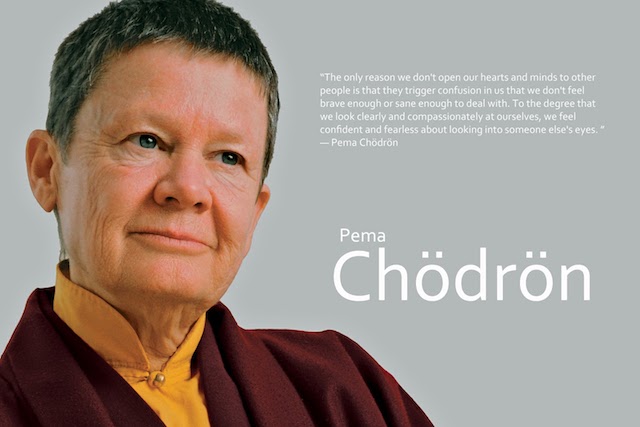“The root cause of non-aggression is gentleness to oneself.”
~ Pema Chodron
In 2009, Pema Chodron and Sakyong Mipham Rinpoche co-led a week long meditation retreat at Shambhala Mountain Center in Colorado entitled Cultivating Gentleness and Strength.
When Pema Chodron speaks about relating to life in a sane way, people listen. They listen because of her friendly demeanor, her plainspoken and personable manner, and because they know what she is saying is true (though unconventional).
By learning to stay awake and open to everything that happens in our lives, we can learn to experience fully, which leads to non-aggression, in ourselves and in our actions.
The choices we make will change our life, and the world, for better or worse, she said.
When we acknowledge the onset of a thought that is pulling us around by the nose, or a strong emotion that is making our blood boil or our heart constrict, we can follow these three steps:
1. Drop the story line.
We really learn to do this during our meditation practice. Shamatha meditation is primarily a method of breaking habits. We learn to touch and let go of our thoughts, relaxing into the present moment, over and over, so that when a situation arises in our daily life, we can more easily touch and let go of a story in our head. This catch and release method is strengthened by the repetitions we put in on the cushion.
Dropping the story line is noticing the story racing around in our minds, cutting its string, and again resting our mind on what is happening in the moment.
2. Have a sense of the vast universal space.
This is a personal notion, i.e., something you have to experience intimately and directly, rather than philosophically.
When we relax into the present moment the barriers between ourselves and the rest of the cosmos dissolve. We can begin to experience a sense, and inseparability, of ourselves and this space.
The familiarity of this develops, again, during our meditation practice, but it is something available at any moment. When we are able to relax into the spaciousness of reality, there is a lot more room for thoughts and emotions to arise. We can accommodate them much more easily when they are not filling and entirely consuming our entire experience.
3. Abide with the energy.
Pema points out that wakefulness is just as prevalent in the energy of rage as it is in compassion. If we can take the attitude that nothing wrong has happened, we can recognize that it’s all just good energy.
After completing the first two steps and staying with the physical sensations of the energy, it is just heat, it is just a tingling in your belly. It is neither good nor bad. It is just a surge of energy.
If we can learn to just be with that experience, we can learn to live an open and awake life.
Once Pema said that any emotion that we experience naturally only lasts about a minute. If we are still experiencing it after that it’s because we are fueling it with our thoughts—fear, anger, aggression, worry, doubt, etc.
Half of the battle here is remembering the technique. It takes an intention to practice this. We could decide when starting our day that it is our intention to practice this technique when a suitable situation arises. Then we can do our best to be mindful of our intention throughout our day. It’s starts by doing it once!
A bodhisattva or Shambhala warrior is someone with the bravery to remain open to the world and meet whatever arises with non-aggression.
This is a more healthy and sane way to relate with our experience. We can learn to appreciate the sweet and the sour, not by indulging or repressing, but by knowing and experiencing it fully.
~
~
~
Love elephant and want to go steady?
Sign up for our (curated) daily and weekly newsletters!
Photo: Luc Reid



Read 3 comments and reply